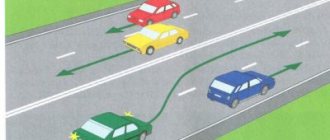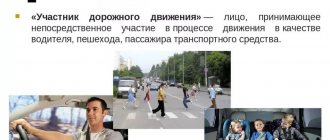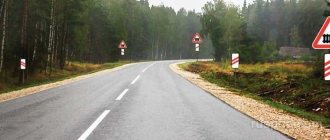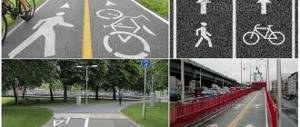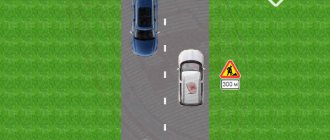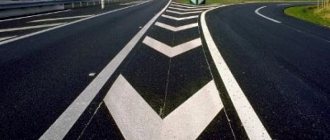Official interpretation for 2021
8.1. Before starting to move, change lanes, turn (U-turn) and stop, the driver is required to give signals with turn signals in the appropriate direction, and, if they are missing or faulty, with his hand. When performing a maneuver, there should be no danger to traffic or interference with other road users.
The signal for a left turn (turn) corresponds to the left arm extended to the side or the right arm extended to the side and bent at the elbow at a right angle upward. The right turn signal corresponds to the right arm extended to the side or the left arm extended to the side and bent at the elbow at a right angle upward. The brake signal is given by raising your left or right hand.
Last modified
The last and only time amendments to clause 8.1 of the traffic rules were made by Government Decree No. 316 on May 10, 2010. The second sentence of the first paragraph has been changed:
| Before the change | After change |
| 8.1. Before starting to move, change lanes, turn (U-turn) and stop, the driver is required to give signals with turn signals in the appropriate direction, and, if they are missing or faulty, with his hand. In this case, the maneuver must be safe and not interfere with other road users. | 8.1. Before starting to move, change lanes, turn (U-turn) and stop, the driver is required to give signals with turn signals in the appropriate direction, and, if they are missing or faulty, with his hand. When performing a maneuver, there should be no danger to traffic or interference with other road users. |
What is prohibited to do
When starting to move the vehicle, it is prohibited to perform the following actions:
- start driving without making sure that the vehicle complies with the Basic Provisions for the Admission of Vehicles...;
- mislead other road users with turn signals - for example, alternately turn on the left and then the right turn signal or turn on the left turn signal while turning right;
- make a U-turn in places where it is prohibited by the corresponding sign or clause 8.11. Rules - that is, at pedestrian crossings, in tunnels, on bridges, overpasses, at public transport stops, etc.;
- drive in reverse at intersections and where turning around is prohibited;
- make a turn in such a way that the car will be in the oncoming lane (clause 8.6. Rules).
Comments to clause 8.1 of the traffic rules
So, this point:
- regulates the rules for using turn signals during maneuvers,
- regulates that when performing maneuvers you must give way in general cases (if more specific traffic rules or signs do not establish an advantage).
Rules for using turn signals during simple maneuvers
Actually, everything here is quite simple - during certain maneuvers you need to turn on the following turn signals:
- when turning left - left,
- when turning right - right,
- when changing lanes - according to the direction of changing lanes,
- when starting to move from the side of the road or the edge of the road - according to the direction of movement: from the right edge - left,
- from the left edge (this is allowed on a one-way road or on a two-way road without a continuous one) - right,
When overtaking
Here, many drivers make the mistake of turning on and not turning off the left turn signal throughout the overtaking process.
Meanwhile, overtaking itself consists of 2 maneuvers: changing lanes to the left (oncoming lane), moving straight ahead, and then changing lanes to the right (passing) lane.
And in this case, according to paragraph 8.1 of the Rules, you should turn the direction indicators on and off 2 times:
- when changing lanes into oncoming traffic - left, then immediately after changing lanes it must be turned off, otherwise other road users will think that you are turning left from the road,
- when returning to your lane - right.
Let us also remind you that, according to paragraph 8.2 of the traffic rules, the turn signal must be turned on in advance, and turned off immediately after the end of the maneuver. Paragraph 8.1 of the traffic rules, in addition, prescribes not to interfere with overtaking (the driver of the blue car in the diagram above), but a more specific prohibition on this is contained in paragraphs 11.1 and 11.2 of the Rules.
On a roundabout
In this situation, everything is a little more complicated. According to the current traffic rules for 2021, the roundabout is an intersection (clause 13.11.1).
However, the circle itself is considered traffic on the road. Hence:
- when entering a roundabout, you make a right turn (paragraph 8.5 of the traffic rules) - you need to turn on the right turn signal,
- when driving around a roundabout, turn off the turn signal (and no left turn signals),
- when entering the roundabout, turn the right turn signal again.
Everything in these points looks logical, if not for one “but”. Traffic management at many roundabouts is often inconsistent and does not make it obvious that a right turn is being made. For example, here's an intersection:
Here the driver can mislead other road users if he turns on the right turn signal.
Remember also that you can enter the roundabout from any lane, but exit only from the right.
What must a driver do before moving off?
Section 2 of the Rules regulates that before setting off on the road, a motorist must:
- check the availability of documents presented at the request of traffic police officers (VU, SRTS, MTPL insurance policy, if necessary, a waybill or documentation for the cargo being transported);
- ensure the proper technical condition of the vehicle, in particular, check that there are no deficiencies specified in the “List of faults and conditions...”;
- check the availability of the necessary tools and materials - first aid kit, fire extinguisher, reflective vest, socket wrench for changing a wheel, warning triangle, etc.;
- fasten your seat belt (if the car is equipped with one), and also make sure that all passengers are fastened.
Before driving at a traffic light
As stated in paragraph 6.1. Rules, signals (sections) of traffic lights can be:
- round (the most common option);
- in the form of arrows;
- in the shape of a pedestrian or bicycle silhouette;
- X-shaped.
The colors of the signals are known to everyone since childhood:
| red | movement is prohibited |
| green | you can go |
| green flashing | you can drive, but take into account that soon (in a couple of seconds) the yellow signal will turn on |
| yellow | signals a change of signals and prohibits movement |
| yellow flashing | signals that the traffic light is not working and that you need to follow the priority signs |
Starting from a traffic light (if you stopped at it) is done as follows:
- it is checked that the intersection is controlled (that is, that the yellow signal is not flashing);
- the corresponding extreme position is taken in advance (to turn left you need to take the far left lane, to turn right - the right, unless otherwise regulated by signs or markings);
- The turn signal turns on or, if it does not work, a hand signal is given (clause 8.1. Rules) (except for cases when driving straight ahead);
- the enabling signal is expected to turn on;
- movement begins;
- in case of a left turn, oncoming cars and those turning right, as well as pedestrians, are allowed to pass (clause 13.4 of the Rules);
- when turning right, pedestrians are allowed to pass, as well as a tram, if it also moves to the main green signal (clause 13.6 of the Rules).
When changing lanes
Changing lanes will be required if it is necessary to occupy a lane for movement or subsequent maneuver.
For example, the driver saw sign 5.15.1., ordering to turn right only from the far right lane. If a motorist is in a different lane, he will need to change lanes.
The order is as follows:
- turning on the turn signal (or giving a hand signal, details below);
- use of rear-view mirrors to pass vehicles moving in the same direction and not changing direction;
- turn off the turn signal and complete the maneuver.
If 2 vehicles started changing lanes at the same time, the driver on the right will have priority (clause 8.4 of the Rules).
When the bus leaves the stop
In clause 18.3. The Rules contain the main requirement - within the boundaries of cities, route vehicles have priority when leaving the area indicated by sign 5.16. or 5.17. stopping places.
Accordingly, if a trolleybus or bus starts moving ahead of the stop pavilion, it is necessary to reduce the speed and allow it to take its lane. Only after this can you begin to carry out maneuvers (overtaking, advancing, etc.).
It should be taken into account that the motorist is also obliged to give way to pedestrians who are moving towards the stop of the route vehicle (if boarding and disembarking is carried out from the roadway - clause 14.6 of the Rules).
What is yellow markings in traffic regulations is described in the article: yellow markings in traffic regulations. Who should yield to whom when changing lanes in traffic rules, read here.
Reversing
The main requirement before starting to reverse is presented in paragraph 8.12. Rules
Before engaging reverse gear, the driver must:
- make sure that the rear mirrors are in working order and that the maneuver being performed is safe;
- if moving backwards is difficult due to a large number of objects or people, you should seek the help of other persons;
- if there is an opportunity to turn around and move forward and not backward, it (the opportunity) should always be used;
- you also need to check whether reversing is not prohibited - in particular, this maneuver cannot be performed at pedestrian crossings, in tunnels, at railway crossings, at stops for route vehicles and at intersections.
From the curb
In accordance with clause 1.2. Rules, a shoulder is an element of a highway that is directly adjacent to the roadway and is at the same level with it.
Determining the shoulder is very simple - it differs from the main roadway in the type of coverage. As a rule, this is soil, and asphalt is laid on the main roadway.
Stopping on the right side of the road is permitted by the Rules (see clause 12.1.). You can also stop on the left side of the road, but only on the condition that the stop is carried out:
- within a populated area;
- on a road with 1 lane for each direction;
- on a road that does not have tram lines in the middle.
Please note that when making maneuvers from the side of the road, motorists should be careful. Based on clause 4.1. According to the rules, this element of the road can be used by pedestrians, people in wheelchairs, as well as citizens transporting bulky objects.
In addition, groups of children are allowed to move along the roadsides (during the day and only accompanied by adults - paragraph 2, clause 4.2 of the Rules). Also on the side of the road, pedestrians can wait for a route vehicle (clause 4.8 of the Rules).
The main rule when starting to move from the side of the road is to allow (not interfere with) other road users and give the appropriate turn signal.
It is important that when starting to move from the side of the road in the lane immediately adjacent to it, you only need to let pass passing vehicles, and if necessary, enter the lane adjacent to the opposite side of the road - both oncoming and passing vehicles (see picture).
From the parking lot
Based on clause 1.2. Rules, a parking lot or a parking space is considered a specially equipped area that is part of the road and directly adjacent to the sidewalk or curb, serving for parking cars on a paid or free basis (as decided by the owner).
Here, in paragraph 1.2. The Rules define what an adjacent territory is - this is an area directly adjacent to the road and not used for through traffic of vehicles.
Parking is indicated by information sign 6.4., which can be used in conjunction with information signs regulating the method of parking the vehicle (8.6.1. - 8.6.9.).
When starting to move from the parking lot, the general rule for leaving the adjacent territories applies - that is, the motorist must give way to everyone who is on the main roadway - cyclists, horse-drawn carts, mechanical vehicles, etc.
The requirement provided for in clause 8.1. The rules also apply - that is, it is necessary to give the appropriate turn signal.
With a change in direction
Changing the direction of movement means turning around. It is necessary to perform this maneuver after making sure that there is no interference for other road users and that it is safe.
The main requirement before making a turn is the need to turn on the left turn signal. If the signals do not work, hand signals should be used (see below).
If the driver is moving on a multi-lane road, for this maneuver you need to take the appropriate extreme position (left) (clause 8.5. Rules). An exception is if signs 5.15.1., 5.15.2. or markup 1.18. indicate the need to make a U-turn from any lane.
The driver should also pay attention to the presence of passing tram lines located at the same level with the road (neither higher nor lower). If not 5.15.1. and 5.15.2., then the turn must be made from the passing tram line.
The further procedure depends on where the maneuver is performed - outside the intersection or within it:
- in the 1st case, you need to give way to a passing tram and oncoming vehicles (clause 8.8 of the Rules);
- in the 2nd case, it all depends on which intersection - controlled or unregulated, so you need to give way to all those to whom you give way according to the rules for driving through controlled and unregulated intersections when turning left (for example, when turning at a traffic light, you need to give way to oncoming cars and trams , if the main green signal is on for it).
When rising
Steep ascents and descents are indicated respectively by warning signs 1.14. and 1.13.
The Rules do not establish any special requirements regarding the order of movement on ascents and descents. The only thing you should pay attention to is the situation when oncoming traffic on an ascent or descent is difficult (for example, if there is a narrow roadway).
In this case, based on clause 11.7. The rule is that the driver who is moving downhill must give way. The one who is on the rise will have priority.
Important note!
- This article provides basic information, but each case is different.
- In 92% of all situations there are important nuances that can affect the outcome of the entire case.
- An experienced lawyer will study all the materials of the case and indicate in which direction to move.
Therefore, our website employs on-duty legal consultants who delve into each case and are aimed at solving it.
Ask a Question
or consult toll-free (Moscow), (St. Petersburg), 8 (all of Russia).
Fine for violating clause 8.1 of traffic rules
The sanction for failure to use turn signals in violation of 8.1 of the Rules is minimal - only 500 rubles or a warning under Part 1 of Article 12.14 of the Administrative Code. This fine can also be paid at a discount within 20 days from the date of the decision.
The same penalty is provided for causing interference contrary to the second sentence of paragraph 8.1, but under Part 3 of the same article.
Both violations are recorded visually by a traffic police officer, and in the event of a setup, it is very difficult to prove that the turn signal was turned on, since even the video recorder in the car rarely records the turn signal being turned on.
Fines and other penalties
Here is a list of fines and other penalties imposed on the driver in case of violation of the Rules when starting to drive:
| The essence of the violation | Regulatory regulations under the Code of Administrative Offenses | Possible sanctions |
| Failure to comply with the requirements of clause 2.3.1. Rules regulating the need to check the compliance of a vehicle before driving with the Basic Provisions for Admission... | Art. 12.5. | As a rule, a warning or a fine of 500 rubles, but there may also be deprivation (in the case of the presence of xenon, illegal devices for producing sound signals, etc.) |
| Failure to comply with the requirements of clause 2.1.2. Rules | Art. 12.6, Art. 12.29 | The fine for the driver is 1000 rubles, for each unbelted passenger - a warning or 500 rubles |
| Failure to comply with the requirement para. 2 clause 2.7. Rules | Part 1 art. 12.8 | Fine 30,000 + deprivation of rights for a period of 1.5 to 2 years |
| Starting at a red traffic light | Part 1 art. 12.12 | Fine 1000 rubles |
| Violation of the rules of maneuvering, for example, leaving the side of the road and not allowing vehicles taking advantage of the right of way | Part 3 art. 12.14 | Warning or fine 500 rubles |
| Failure to signal with a turn signal in cases where it is necessary according to the Rules | Part 1 art. 12.14. | Warning or fine 500 rubles |
| Refusal to pass a route vehicle leaving the stopping place | Part 1 art. 12.17 | Warning or fine 500 rubles |
So, when starting to drive, the motorist must ensure that he gives priority to those vehicles that have it in accordance with the provisions of the Rules.
You almost always need to give way when starting to move - for example, from the side of the road, from a parking lot or parking lot, on a descent, when changing lanes, etc.
About information signs in traffic rules, read the article: information signs in traffic rules. The bus stop sign in the traffic rules is discussed on the page.
Find out about the spike sign in the new traffic rules from June 1, 2021 from this information.
Arbitrage practice
- Decision No. 12-438/2014 on changing lanes without a turn signal when deliberately cutting off another vehicle in violation of clause 8.1 of the traffic rules - that is, this decision includes both violations from the text of clause 8.1: failure to use direction indicators, and creating interference and danger for traffic during maneuver .
- Partially satisfying the claim was Court Decision No. 12-145/2017 in a situation where one driver was overtaking and the other (overtaken) was turning left, where a dispute took place about the turn signal not being turned on and interfering with the maneuver.
